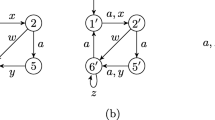Abstract
An approach to the problem of complete testing is proposed. Testing is interpreted as the check of an implementation’s conformance to the given requirements described by a specification. The completeness means that a test suite finds all the possible implementation errors. In practice, testing must end in a finite amount of time. In the general case, the requirements of completeness and finiteness contradict each other. However, finite complete test suites can be constructed for certain classes of implementations and specifications provided that there are specific test capabilities. Test algorithms are proposed for finite specifications and finite implementations with limited nondeterminism for the case of open-state testing. The complexity of those algorithms is estimated.
Similar content being viewed by others
Explore related subjects
Discover the latest articles, news and stories from top researchers in related subjects.References
Bourdonov, I.B., Kossatchev, A.S., and Kuliamin, V.V., Formalization of Test Experiments, Programmirovanie, 2007, no. 5, pp. 3–32 [Programming Comput. Software (Engl. Transl.), 2007, vol. 33, no. 5, pp. 239–260].
Bourdonov, I.B., Kossatchev, A.S., and Kuliamin, V.V., Teoriya sootvetstviya dlya system s blokirovkami i razrusheniem (Conformance Theory for Systems with Refusals and Destruction), Moscow: Nauka, 2008.
Bourdonov, I.B., Conformance Theory for the Functional Testing of Software Systems Based on Formal Models, Doctoral (Math.) Dissertation, Moscow: Institute for System Programming, Russian Academy of Sciences, 2008; http://www.ispras.ru/~RedVerst/RedVerst/Publications/TR-01-2007.pdf.
van Glabbeek, R.J., The Linear Time—Branching Time Spectrum, Proc. of CONCUR’90, Baeten, J.C.M. and Klop, J.W., Eds., Lect. Notes Comput. Sci., 1990, vol. 458, pp. 278–297.
van Glabbeek, R.J., The Linear Time—Branching Time Spectrum II: The Semantics of Sequential Processes with Silent Moves, Proc. of CONCUR’93, Hildesheim, Germany, 1993, Best, E., Ed., Lect. Notes Comput. Sci., 1993, vol. 715, pp. 66–81.
Milner, R., Modal Characterization of Observable Machine Behavior, Proc. CAAP, 1981, Astesiano, G. and Bohm, C. Eds., Lect. Notes Comput. Sci., 1981, vol. 112, pp. 25–34.
Bourdonov, I.B., Kossatchev, A.S., and Kuliamin, V.V., Irredundant Algorithms for Traversing Directed Graphs: The Nondeterministic Case, Programmirovanie, 2004, no. 1, pp. 4–24 [Programming Comput. Software (Engl. Transl.), 2004, vol. 30, no. 1, pp. 2–17].
Blass, A., Gurevich, Y., Nachmanson, L., and Veanes, M., Play to Test Microsoft Research, Techn. Report, MSR-TR-2005-04, 2005, 5th Int. Workshop on Formal Approaches to Testing of Software (FATES 2005), Edinburgh, 2005.
Fujiwara, S. and Bochmann, G.V., Testing Nondeterministic Finite State Machine with Fault Coverage, in Proc. of the Fourth IFIP TC6 Int. Workshop on Protocol Test Systems, 1991, Kroon, J., Heijing, R.J., and Brinksma, E., Eds., North-Holland, 1992, pp. 267–280.
Milner, R., Calculus of Communicating Processes, Lect. Notes Comput. Sci., 1982, vol. 92.
Bourdonov, I.B., Kossatchev, A.S., and Kuliamin, V.V., Irredundant Algorithms for Traversing Directed Graphs: The Deterministic Case, Programmirovanie, 2003, no. 5, pp. 11–30 [Programming Comput. Software (Engl. Transl.), 2003, vol. 29, no. 5, pp. 245–258].
Kuliamin, V.V., Petrenko, A.K., Kossatchev, A.S., and Bourdonov, I.B., The UniTesK Approach to Designing Test Suites, Programmirovanie, 2003, no. 6, pp. 25–34 [Programming Comput. Software (Engl. Transl.), 2003, vol. 29, no. 6, pp. 310–322].
Petrenko, A., Yevtushenko, N., and Bochmann, G.V., Testing Deterministic Implementations from Nondeterministic FSM Specifications, in Selected Proc. of the 9th IFIP TC6 Int. Workshop on Testing of Communicating Systems, 1996.
Goodenough, J.B. and Gerhart, S.L., Toward a Theory of Test Data Selection, IEEE Trans. Software Eng., 1975, vol. SE-1, no. 2, pp. 156–173.
Grochtmann, M. and Grimm, K., Classification Trees for Partition Testing, Software Testing, Verificcation and Reliability, 1993, no. 3, pp. 63–82.
Zhu, Hall, May, Software Unit Test Coverage and Adequacy, ACM Comput Surveys, 1997, vol. 29, no. 4.
Bourdonov, I.B., Kossatchev, A.S., and Kuliamin, V.V., Application of Finite Automatons for Program Testing, Programmirovanie, 2000, no. 2, pp. 12–28 [Programming Comput. Software (Engl. Transl.), 2000, vol. 26, no. 2, pp. 61–73].
Vasilevskii, M.P., On the Detection of Faults in an Automaton, Kibernetika, 2973, vol. 9, no. 4, pp. 93–108.
Aho, A.V., Dahbura, A.T., Lee, D., and Uyar, M.Ü., Optimization Technique fpr Protocol Conformance Test Generation Based on UID Sequences and Rural Chinese Postman Tours, IEEE Trans. Commun., 1991, vol. 3, no. 11, pp. 1604–1615.
Lee, D. and Yannakakis, M., Testing Finite State Machines: State Identification and Verification, IEEE Trans. Comput., 1994, vol. 43, no. 3, pp. 306–320.
Lee, D. and Yannakakis, M., Principles and Methods of Testing Finite State Machines—A Survey, in Proc. of the IEEE 84, 1996, no. 8, pp. 1090–1123.
Legeard, B., Peureux, F., and Utting, M., Automated Boundary Testing from Z and B, Proc. of the Int. Conf. on Formal Methods Europe, FME’02, Lect. Notes Comput. Sci., 2002, vol. 2391, pp. 21–40.
Bourdonov, I.B., Traversal of an Unknown Directed Graph by a Finite Robot, Programmirovanie, 2004, no. 4, pp. 11–34 [Programming Comput. Software (Engl. Transl.), 2004, vol. 30, no. 4, pp. 188–203].
Bourdonov, I.B., Backtracking Problem in the Traversal of an Unknown Directed Graph by a Finite Robot, Programmirovanie, 2004, no. 6, pp. 6–29 [Programming Comput. Software (Engl. Transl.), 2004, vol. 30, no. 6, pp. 305–322].
Bourdonov, I.B., Examination of Unidirectional and Bidirectional Distributed Networks by a Finite Robot, Trudy Vserossiiskoi konferentsii nauchnyi servis v seti Internet (Proc. of the All-Russia Conf. on the Research Services on the Internet), 2004.
Edmonds, J. and Johnson, E.L., Matching, Euler Tours, and the Chinese Postman, Math. Programm., 1973, no. 5, pp. 88–124.
Bourdonov, I.B., Kossatchev, A.S., and Kuliamin, V.V., “Security, Verification, and Conformance Theory,” in Materialy vtoroi mezhdunarodnoi nauchnoi konferentsii po problemam bezopasnosti i protivideistviya terrorizmu (Proc. of the Second Int. Conf. on Security Problems and Terrorism Counteractions), Moscow: MNTsMO, 2007.
Author information
Authors and Affiliations
Corresponding author
Additional information
Original Russian Text © I.B. Bourdonov, A. S. Kossatchev, 2009, published in Programmirovanie, 2009, Vol. 35, No. 6.
Rights and permissions
About this article
Cite this article
Bourdonov, I.B., Kossatchev, A.S. Complete open-state testing of limitedly nondeterministic systems. Program Comput Soft 35, 301–313 (2009). https://doi.org/10.1134/S0361768809060012
Received:
Published:
Issue Date:
DOI: https://doi.org/10.1134/S0361768809060012



